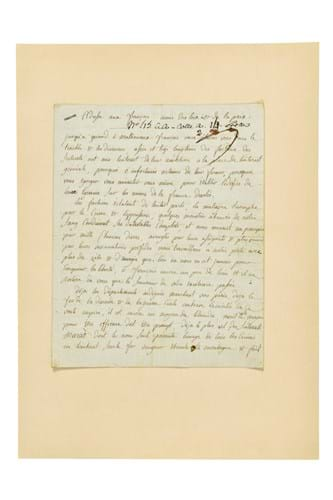
A manuscript letter written by Charlotte Corday to the French people which she took with her when she set out to assassinate Marat, €215,000 at Osenat.
In the letter Corday laid out her reasons for her actions on July 13, 1793, when she entered Marat’s house and stabbed him through the heart while he was taking a medicinal bath. The scene of her crime was memorably depicted by Jacques-Louis David in his painting The Death of Marat.
Corday, just 24, was arrested, imprisoned, tried, convicted and guillotined just four days later.
The letter titled ‘Address to French friends of law and peace’ was discovered folded and pinned inside her bodice when she was searched at the prison de l’Abbaye.
Girondins and Jacobins
Corday, a Girondin from Caen, Normandy, believed the revolution was in jeopardy due to the radical actions of the Jacobins, the rival political group led by Marat. She blamed Marat for the deaths during the September Massacres of 1792.
The letter has a long commercial provenance back to an auction in 1834 when it belonged to the Lyon historian François-Nicolas Cochard. It has made several subsequent appearances at auction.
Estimated at €80,000- 100,000, it was hammered down at €215,000/£182,750 (€270,900 including buyer’s premium) at Osenat in Versailles on June 11.
The directorate of Heritage and Culture of Normandy, the city of Caen and the region of Calvados teamed up to buy the letter. They hope to put it on display in the former Abbaye aux Dames in Caen, Charlotte Corday’s home town.
However, following the auction, France’s Ministry of Culture announced it planned to put the letter in the national archive.
According to media reports this has enraged the buyers. Instead of the usual procedure of exercising a pre-emption right at the auction, the state issued its decision following the Normandy group’s purchase.
According to Le Figaro, the centrist president of the Normandy region said: “Decidedly, facing the Girondins, Robespierre continues to reign in certain Parisian minds!”
Osenat said the document would remain in its possession while waiting to receive the official request for a ‘claim’ from the Ministry of Culture.






